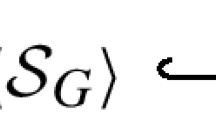Abstract
The Euler characteristic is the only additive topological invariant for spaces of certain sort, in particular, for manifolds with certain finiteness properties. A generalization of the notion of a manifold is the notion of a V-manifold. We discuss a universal additive topological invariant of V-manifolds, the universal Euler characteristic. It takes values in the ring freely generated (as a Z-module) by isomorphism classes of finite groups. We also consider the universal Euler characteristic on the class of locally closed equivariant unions of cells in equivariant CW-complexes. We show that it is a universal additive invariant satisfying a certain “induction relation.” We give Macdonald-type identities for the universal Euler characteristic for V-manifolds and for cell complexes of the described type.
Similar content being viewed by others
References
M. Atiyah and G. Segal, “On equivariant Euler characteristics,” J. Geom. Phys., 6:4 (1989), 671–677.
J. Bryan and J. Fulman, “Orbifold Euler characteristics and the number of commuting mtuples in the symmetric groups,” Ann. Comb., 2:1 (1998), 1–6.
W. Chen and Y. Ruan, “Orbifold Gromov–Witten theory,” in: Orbifolds in Mathematics and Physics (Madison, WI, 2001), Contemp. Math., vol. 310, Amer. Math. Soc., Providence, RI, 2002, 25–85.
L. Dixon, J. Harvey, C. Vafa, and E. Witten, “Strings on orbifolds,” Nuclear Phys. B, 261:4 (1985), 678–686.
L. Dixon, J. Harvey, C. Vafa, and E. Witten, “Strings on orbifolds. II,” Nuclear Phys. B, 274:2 (1986), 285–314.
M. R. Dixon and T. A. Fournelle, “The indecomposability of certain wreath products indexed by partially ordered sets,” Arch. Math., 43 (1984), 193–207.
C. Farsi and Ch. Seaton, “Generalized orbifold Euler characteristics for general orbifolds and wreath products,” Algebr. Geom. Topol., 11:1 (2011), 523–551.
S. M. Gusein-Zade, “Equivariant analogues of the Euler characteristic and Macdonald type formulas,” Uspekhi Mat. Nauk, 72:1(433) (2017), 3–36; English transl.: Russian Math. Surveys, 72:1 (2017), 1–32.
S. M. Gusein-Zade, I. Luengo, and A. Melle-Hernández, “A power structure over the Grothendieck ring of varieties,” Math. Res. Lett., 11:1 (2004), 49–57.
S. M. Gusein-Zade, I. Luengo, and A. Melle-Hernández, “On the power structure over the Grothendieck ring of varieties and its applications,” Trudy Mat. Inst. Steklov., 258 (2007), 58–69; English transl.: Proc. Steklov Inst. Math., 258:1 (2007), 53–64.
S. M. Gusein-Zade, I. Luengo, and A. Melle-Hernández, “Equivariant versions of higher order orbifold Euler characteristics,” Mosc. Math. J., 16:4 (2016), 751–765.
S. M. Gusein-Zade, I. Luengo, and A. Melle-Hernández, “Grothendieck ring of varieties with finite groups actions,” Proc. Edinb. Math. Soc., Ser. 2 (to appear); https://arxiv.org/abs/1706.00918.
F. Hirzebruch and T. Höfer, “On the Euler number of an orbifold,” Math. Ann., 286:1–3 (1990), 255–260.
D. Knutson, λ-Rings and the Representation Theory of the Symmetric Group, Lecture Notes in Math., vol. 308, Springer-Verlag, Berlin–New York, 1973.
P. M. Neumann, “On the structure of standard wreath products of groups,” Math. Z., 84 (1964), 343–373.
I. Satake, “On a generalization of the notion of manifold,” Proc. Nat. Acad. Sci. U.S.A., 42 (1956), 359–363.
I. Satake, “The Gauss–Bonnet theorem for V-manifolds,” J. Math. Soc. Japan, 9 (1957), 464–492.
H. Tamanoi, “Generalized orbifold Euler characteristic of symmetric products and equivariant Morava K-theory,” Algebr. Geom. Topol., 1 (2001), 115–141.
T. tom Dieck, Transformation Groups, De Gruyter Studies in Math., vol. 8, Walter de Gruyter, Berlin, 1987.
C. E. Watts, “On the Euler characteristic of polyhedra,” Proc. Amer. Math. Soc., 13 (1962), 304–306.
Author information
Authors and Affiliations
Corresponding author
Additional information
Translated from Funktsional′nyi Analiz i Ego Prilozheniya, Vol. 52, No. 4, pp. 72–85, 2018
The work of the first author (Sections 2, 5, and 6) was supported by the Russian Science Foundation, grant 16-11-10018. The work of the second and third authors was partially supported by the competitive Spanish national grant MTM2016-76868-C2-1-P.
Rights and permissions
About this article
Cite this article
Gusein-Zade, S.M., Luengo, I. & Melle-Hernández, A. The Universal Euler Characteristic of V-Manifolds. Funct Anal Its Appl 52, 297–307 (2018). https://doi.org/10.1007/s10688-018-0239-y
Received:
Published:
Issue Date:
DOI: https://doi.org/10.1007/s10688-018-0239-y



